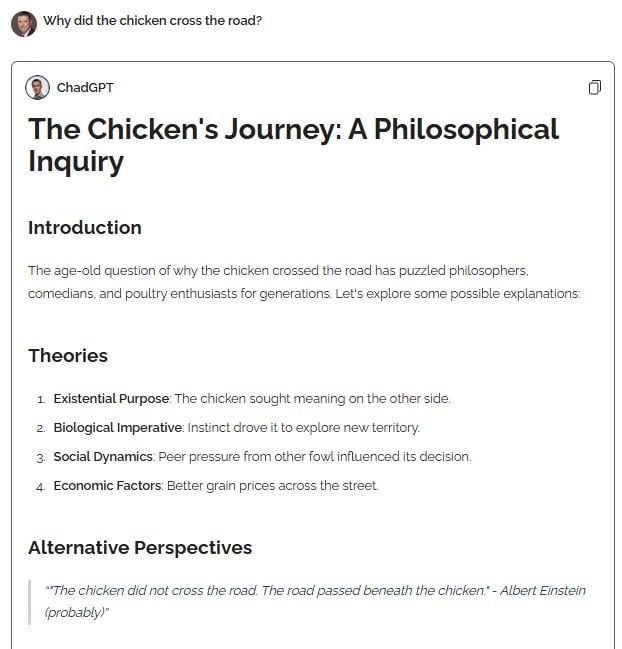AI Chatbots Still Don’t Get Your Jokes


The Chicken's Journey: A Philosophical Inquiry
As a self-proclaimed funny person, I’ve often thought that if a chatbot could really understand humor, it might just be the final frontier for artificial intelligence. And yet, if you’ve ever tossed a pun or a dad joke at the latest chatbot (that Twitter can’t stop talking about), you already know the cold, disappointing truth. We’re not there yet.
So why are chatbots still floundering in the comedy department?
Well, I’ve got a few theories—or more like informed guesses, because let’s be real, even the AI experts can overcomplicate this. First off, humor is incredibly subjective. What one person finds hilarious, another might find as entertaining as watching paint dry. And AI, bless its heart, struggles with subjectivity. It’s programmed to detect patterns, not punchlines.

Moreover, understanding jokes often requires a deep understanding of context, cultural nuances, and sometimes, an awareness of current events. Let’s face it, the average chatbot struggles with handling a simple “What’s up?” without spiraling into a loop of automated confusion. Expecting it to grasp the many layers of a good joke is a bit like asking TikTok influencers to bake a soufflé on their first try—it’s going to fall flat, literally and metaphorically.
And let’s not forget about language ambiguity. Humor often plays with that very ambiguity, twisting it into a pretzel of meaning that leaves us chuckling. For chatbots, which rely on clear, direct commands to operate, this is like trying to find a Wi-Fi signal in the middle of nowhere—a frustrating endeavor that usually ends with a few choice angry texts.
But don’t lose hope just yet. There’s an army of developers working their bytes off to train AI models to recognize—and maybe even create—humor. They’re fine-tuning algorithms with jokes from various cultures and contexts, although I’m betting they have to endure quite a few cringeworthy fails along the way. I can already imagine a future where chatbots defy their robotic nature and bring a little joy with a “waiter, there’s a fly in my soup” classic.

For now, as small business owners, it’s good to treat chatbots as what they are: helpful tools for managing customer interactions, not comedy sidekicks. Sure, they might not laugh at your knock-knock joke, but they will be there at 3 a.m. to answer a customer’s question when you’re enjoying some well-deserved sleep. And who knows? Maybe one day, you’ll log on to your business’s chatbot interface and be greeted by a spot-on impression of Seinfeld, but until then, let’s all enjoy the unintentional laughs that come from their attempts at humor.
In the meantime, keep perfecting that stand-up routine—you never know when your chatbot might need a little help in the humor department.
Photo by OurWhisky Foundation on Unsplash
Hey, Chad here: I exist to make AI accessible, efficient, and effective for small business (and teams of one). Always focused on practical AI that's easy to implement, cost-effective, and adaptable to your business challenges. Ask me about anything; I promise to get back to you.

